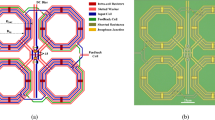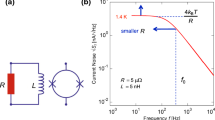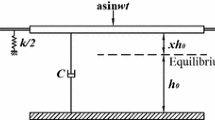Abstract
This paper deals with the calculations of the noise and the optimization of the energy resolution of a dc SQUID with finite junction capacitance. Up to now noise calculations of dc SQUIDs were performed using a model without parasitic capacitances across the Josephson junctions. As the capacitances limit the performance of the SQUID, for a good optimization one must take them into account. The model consists of two coupled nonlinear second-order differential equations. The equations are very suitable for simulation with an analog circuit. We implemented the model on a hybrid computer. The noise spectrum from the model is calculated with a fast Fourier transform. A calculation of the energy resolution for one set of parameters takes about 6 min of computer time. Detailed results of the optimization are given for products of inductance and temperature ofLT=1.2 and 5 nH K. Within a range of β and β c between 1 and 2, which is optimum, the energy resolution is nearly independent of these variables. In this region the energy resolution is near the value calculated without parasitic capacitances. Results of the optimized energy resolution are given as a function ofLT between 1.2 and 10 mH K.
Similar content being viewed by others
References
J. Clarke, W. M. Goubau, and M. B. Ketchen,J. Low Temp. Phys. 25, 99 (1976).
M. W. Cromar and P. Carelli,Appl. Phys. Lett. 28, 723 (1981).
M. B. Ketchen and J. M. Jaycox,Appl. Phys. Lett. 40, 736 (1982).
V. J. de Waal, T. M. Klapwijk, and P. van den Hamer,Appl. Phys. Lett. 42, 389 (1983).
W. C. Stewart,Appl. Phys. Lett. 12, 277 (1968).
D. E. McCumber,J. Appl. Phys. 39, 3113 (1968).
M. Tinkham,Introduction to Superconductivity (McGraw-Hill, 1975), p. 214.
C. D. Tesche and J. Clarke,J. Low Temp. Phys. 29, 301 (1977).
J. J. P. Bruines, V. J. de Waal, and J. E. Mooij,J. Low Temp. Phys. 46, 383 (1982).
S. M. Faris and E. A. Valsamakis,J. Appl. Phys. 52, 915 (1981).
D. B. Sullivan and J. E. Zimmerman,Am. J. Phys. 39, 1504 (1971).
G. I. Rochlin and P. K. Hansma,Am. J. Phys. 41, 878 (1973).
N. R. Werthamer and S. Shapiro,Phys. Rev. 164, 523 (1967).
C. A. Hamilton,Rev. Bci. Instrum. 43, 445 (1972).
C. K. Bak and N. F. Pedersen,Appl. Phys. Lett. 22, 149 (1973).
C. K. Bak,Rev. Phys. Appl. 9, 15 (1974).
J. C. Taunton and M. R. Halse,J. Phys. E 10, 505 (1977).
J. H. Magerlein,Rev. Sci. Instrum. 49, 486 (1978).
A. Yagi and I. Kurosawa,Rev. Sci. Instrum. 51, 14 (1980).
R. W. Henry, D. E. Prober, and A. Davidson,Am. J. Phys. 49, 1035 (1981).
D. E. Prober, S. E. G. Slusky, R. W. Henry, and L. D. Jackel,J. Appl. Phys. 52, 4145 (1981).
J. E. Zimmerman and D. B. Sullivan,Appl. Phys. Lett. 31, 360 (1977).
D. B. Tuckerman,Rev. Sci. Instrum. 49, 835 (1978).
R. W. Henry and D. E. Prober,Rev. Sci. Instrum. 52, 902 (1981).
B. D. Josephson,Phys. Lett. 1, 251 (1962).
B. D. Josephson,Rev. Mod. Phys. 36, 216 (1964).
B. D. Josephson,Adv. Phys. 14, 419 (1965).
J. E. Zimmerman and A. H. Silver,Phys. Rev. 141, 867 (1966).
V. Radhakrishnan and V. L. Newhouse,J. Appl. Phys. 42, 129 (1971).
J. Claassen,J. Appl. Phys. 46, 2268 (1975).
V. Ambegaokar and A. Baratoff,Phys. Rev. Lett. 10, 486 (1963); Erratum,Phys. Rev. Lett. 11, 104 (1963).
G. A. Bekey and W. J. Karplus,Hybrid Computation (Wiley, New York, 1968).
M. Feilmeier,Hybridrechnen (Birkhäuser Verlag, Basel, 1974).
R. F. Voss,J. Low Temp. Phys. 42, 151 (1981).
V. J. de Waal, P. van den Hamer, and T. M. Klapwijk,Appl. Phys. Lett. 42, 389 (1983).
M. B. Ketchen, W. M. Goubau, J. Clarke, and G. B. Donaldson,J. Appl. Phys. 49, 4111 (1978).
V. J. de Waal and T. M. Klapwijk,Appl. Phys. Lett. 41, 669 (1982).
Author information
Authors and Affiliations
Additional information
Financial support provided by the Stitchting voor Fundamenteel Onderzoek der Materie.
Rights and permissions
About this article
Cite this article
de Waal, V.J., Schrijner, P. & Llurba, R. Simulation and optimization of a dc SQUID with finite capacitance. J Low Temp Phys 54, 215–232 (1984). https://doi.org/10.1007/BF00683275
Received:
Issue Date:
DOI: https://doi.org/10.1007/BF00683275




